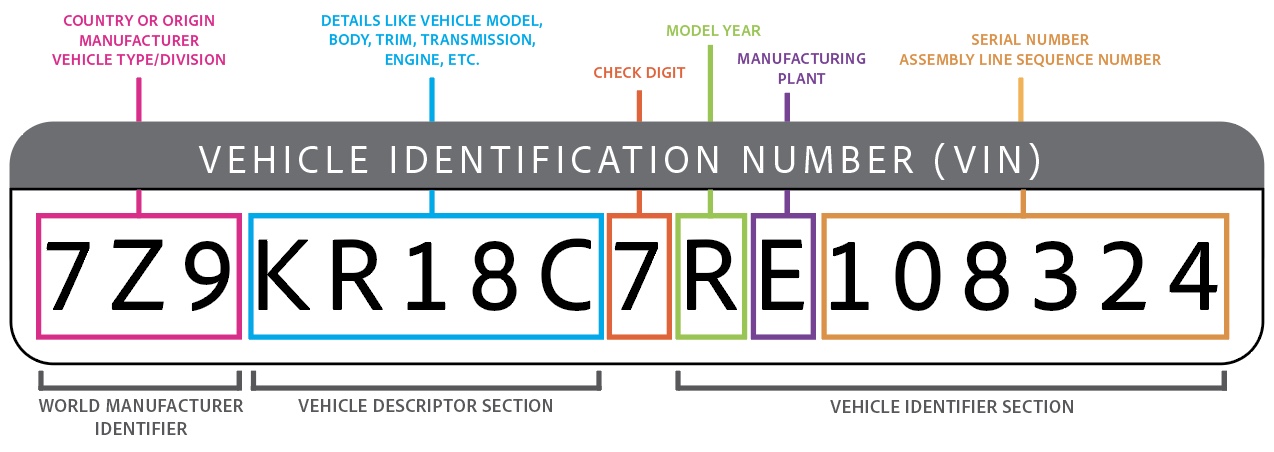A vehicle identification number (VIN) is an alphanumeric code that uniquely identifies your vehicle. Etched and stamped into various areas of your car, each VIN includes a serial number as well as other coded information, like where and when it was manufactured.
Often referred to as VIN numbers — though that’s redundant, since the N already stands for “number” — today’s structure is 17 characters long. Vehicles manufactured before 1981 may have fewer digits, though, or even follow a different structure than today’s standard VINs.
How the VIN came to be
Vehicle and engine identification numbers have been used for vehicle serialization, registration and fraud prevention purposes as early as the 1930s, though the concept was first standardized around 1954. VINs are required for motor vehicles, towed vehicles (such as RVs), motorcycles and mopeds.
It wasn’t until 1978 that the National Highway Traffic Safety Administration (NHTSA) required a specific VIN structure and standardized format, starting with vehicle model years 1981 and beyond. NHTSA also mandates that no two vehicles manufactured within 30 years of each other can have the same VIN.
What a VIN does
Your car’s VIN acts as a unique identifier, which can be deciphered to tell you all about the vehicle. If you need to verify the car’s age, features, trim or engine type, it will all be coded into the VIN.
A VIN is used to track important information about each vehicle’s history, too. Reporting services like Carfax and AutoCheck tie each car’s VIN to alerts like manufacturer recalls. If you’re buying a used car, checking the VIN can provide you with information that you may not get from the existing owner, such as title changes, owner history, odometer readings, service history and accident reports.
When selling your vehicle, providing the VIN can help a buyer confirm details and purchase with confidence. And if your vehicle — or a part of it — is stolen, VIN stamping can help with identification and recovery efforts.
Why would an insurance company ask for my VIN?
You can expect an insurer to ask for your VIN when purchasing a new auto policy or adding a new vehicle to your existing coverage. This helps the insurance company accurately identify your vehicle and calculate its value, safety features and risk level. This information is used to confirm that the right vehicle is being insured, calculate premiums and prevent fraud.
VINs are also used by state regulatory authorities and service providers to accurately evaluate vehicles, as well as track services or large repairs that are completed.
Decoding your VIN
Today’s VINs are globally standardized according to rules set forth by the International Organization of Standardization, with each of the 17 positions serving a specific role. Together, this alphanumeric code allows you to not only identify your unique vehicle but also interpret the year, make, model, trim, key features and manufacturing plant location.

World Manufacturer Identifier (WMI), positions 1-3
The first three characters of today’s VINs are known as the World Manufacturer Identifier (WMI).
The first character can be a number or letter, followed by a letter; together, they specify where the vehicle was built and which company made it. Vehicles manufactured in the United States will have an origin code of 1, 4, 5, 7F through 7Z or 70. Vehicles made in Japan will start with J and those made in China will start with L. The second character represents the manufacturer; for example, General Motors (GM) is usually denoted by G.
The third character can be used to represent the vehicle type (car, bus, RV, etc.) or a manufacturing division within that make — it’s variable and depends on the manufacturer and country it’s built in.
Vehicle Descriptor Section (VDS), positions 4 – 8
The next five characters are the vehicle descriptor section, or VDS, and describe the vehicle’s physical traits. Positions 4 through 8 indicate things like the model, body type, trim, transmission, restraint system and engine size of the vehicle.
Check digit, position 9
The ninth character in your VIN is a “check digit,” or security character, designed to help detect fraudulent VINs. It is determined by a mathematical formula developed by the U.S. Department of Transportation (DOT).
Vehicle Identifier Section (VIS), positions 10 – 17
The remaining eight characters make up the vehicle identifier section, or VIS. Together, these act as your vehicle’s true serial number. They help further identify your vehicle by model year and the specific plant in which it was manufactured, as well as when it came off the assembly line.
- Character No. 10 represents the model year.
- Character No. 11 identifies the manufacturing plant.
- Character Nos. 12 through 17 are the production sequence numbers, determined by assembly line order.
The tenth digit can be particularly confusing, as it often uses a letter to denote the model year. Model years 1980 to 2000 are indicated by the letters A through Y, excluding I, O, Q, U and Z. Model years 2001 through 2009 are indicated by numbers 1 through 9, but the alphabet was used again starting with model year 2010, and will continue through 2030.
| 1980 = A | 1988 = J | 1996 = T | 2004 = 4 | 2012 = C | 2020 = L |
| 1981 = B | 1989 = K | 1997 = V | 2005 = 5 | 2013 = D | 2021 = M |
| 1982 = C | 1990 = L | 1998 = W | 2006 = 6 | 2014 = E | 2022 = N |
| 1983 = D | 1991 = M | 1999 = X | 2007 = 7 | 2015 = F | 2023 = P |
| 1984 = E | 1992 = N | 2000 = Y | 2008 = 8 | 2016 = G | 2024 = R |
| 1985 = F | 1993 = P | 2001 = 1 | 2009 = 9 | 2017 = H | 2025 = S |
| 1986 = G | 1994 = R | 2002 = 2 | 2010 = A | 2018 = J | 2026 = T |
| 1987 = H | 1995 = S | 2003 = 3 | 2011 = B | 2019 = K | 2027 = V |
The manufacturing plant character in position 11 depends on the manufacturer. Each carmaker has their own set of plant codes, so this will vary.
How to decode a VIN before you buy a car
If you want to check your own car’s VIN or learn more about it, there are a few different ways you can go about decoding this number.
Perhaps the most helpful free tool is the NHTSA VIN decoder. This tool is publicly available and will return information about any VIN, including the vehicle’s manufacturing plant. It also has a check digit calculator to help catch fraudulent VIN numbers, which is helpful if you’re checking out a car you’re thinking about purchasing or recently purchased.
Autozone offers a decoder tool that not only checks your car’s VIN, but can also help you find vehicle parts that fit. Many parts are dependent not only on a specific vehicle make and model but also its year and trim, so this tool can help ensure you’re buying the right parts.
Many vehicle history reporting services also offer VIN decoding. This can be especially helpful if you’re checking a car’s history, as the VIN should be tied to any reported accidents, recalls or title changes.
Where is my VIN located?
VIN locations will vary by vehicle type. For road vehicles like cars and trucks, you will usually find the VIN etched:
- Into a plate on the left (driver’s) side of the dashboard, near the windshield.
- On a plate in the driver’s side door jamb.
- Into the engine block.
It can be etched into the windshield and other windows as a security measure. You’ll often find it stamped on the vehicle’s frame and select parts that are commonly stolen, too.
On manufactured trailers, the VIN is usually stamped near the trailer tongue. For motorcycles, there is no requirement to stamp the VIN on the frame, but it does need to be visible without removing any parts.
Aside from physically checking your car for your VIN, you can also find this number on certain documentation. For example, you’ll typically find your VIN printed on your title and registration documents. Insurance companies will include each covered vehicle’s VIN on the policy’s declarations page and often on your insurance card.
FAQs
-
Why doesn’t my VIN have 17 digits?
-
What should I do if my VIN is tampered with or cloned?

Stephanie Colestock is a professional writer, CFEI®, and licensed insurance agent specializing in personal finance. With over 14 years of experience, she crafts insightful and accessible content on a wide range of financial topics, including insurance, loans, credit/debt, investing, retirement planning, and banking.
Her bylines appear in top-tier publications such as TIME, Fortune, MSN, Business Insider, USA Today, Money, Fox Business, and CBS. Stephanie’s deep understanding of complex financial concepts and her ability to communicate them clearly have made her a trusted voice in the industry.
When she’s not writing, Stephanie enjoys SCUBA diving, reading a good book, and traveling the world with her family.

Lacie Glover is a Lead Writer and Editor with sixteen years’ experience in the insurance category. Prior to Jerry, she spent more than a decade on NerdWallet’s content team writing, editing and then overseeing the auto insurance category, as well as dabbling in other insurance and automotive topics. Prior to her career in the online personal finance content space, Lacie spent time in the hard sciences, in clinical research and chemistry labs. She has a bachelor’s degree from Colorado State University.








